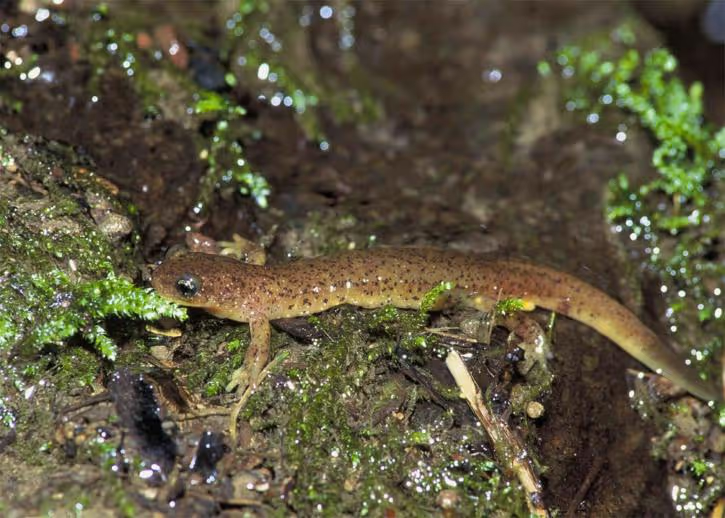The Olympic Torrent Salamander


Once again we return to the Olympic Peninsula to have a look at another endemic species (full list of species endemic to the Olympics can be found here). This time, we’re looking at the sole endemic amphibian, the Olympic torrent salamander (Rhyacotriton olympicus).

They are more abundant on the western side of the Olympics as they prefer cooler, wetter environments. They are found in old-growth coniferous coastal forests in small, cold mountain streams and spring seepages. They tend to be more abundant in streams with northerly aspects and steep gradients (Bury and Adams 2000). They aren’t usually found more than a meter away from a water source.
According to the Washington Department of Fish and Wildlife (WDFW), “Most known occurrences (77 percent) are within Olympic National Park, with an additional 15 percent of locations on the Olympic National Forest.” Recent surveys showed the species to be widespread throughout the Olympic National Park, occurring in 41% of 168 streams and 47% of 235 seeps surveyed (Bury and Adams 2000).
Olympic torrent salamanders are small—less than 2.5 inches (10 cm) in length. They are dark brown with white spots. Their bellies are bright yellow and when threatened they will flash this coloration as a warning to predators. They can live to about ten years and start breeding around 5-6 years of age. Males have large square lobes behind their cloaca.
Breeding can occur year-round, but peaks in the spring. Both males and female typically mate with multiple partners. Females deposit eggs into narrow crevices or under rocks, making nests difficult to find for researchers and predators both. Average clutch size is estimated to be about 7-8.
Because the nests are quite safe, Olympic salamanders do not parent their young. Embryos hatch after about nine months and stop feeding from the egg yolk after an additional three months. The larval stage lasts around 3-4 years, after which they metamorphose into juveniles. It will take them another 1-1.5 years to reach sexual maturity.
Invertebrates make up the entirety of an Olympic salamander’s diet. Larvae feed on aquatic invertebrates such as flatworms, annelids, snails, arachnids, and insects. Adults expand their diet to include semi-aquatic invertebrates, including beetles, stoneflies, snails, flies, and amphipods.
Olympic torrent salamanders are listed as vulnerable on the IUCN Red List due to their limited geographical spread and their susceptibility to changes in their habitat. Climate change is a threat as these salamanders cannot survive in areas where the water temperature is too high. However, logging is considered the main treat to Olympic torrent salamanders. Removing trees from their habitat affects sedimentation of the streams they live in. It also can impact water temperature as fewer trees mean more direct sunlight on streams.
Much is still unknown about Olympic salamanders. The genus Rhyacotriton was first classified in 1917 by Helen Thompson Gaige, then scientific assistant of reptiles and amphibians for the Museum of Zoology at the University of Michigan. Most studies conducted on Olympic salamanders are relatively recent (1960s to present), but more still need to be done if we hope to understand them more fully. You can help by reporting any sightings to WDFW, which can be done at wdfw.wa.gov/get-involved/report-observations.
References
Burke Museum. Olympic torrent salamander. (n.d.). Retrieved March 13, 2021, from https://www.burkemuseum.org/collections-and-research/biology/herpetology/amphibians-reptiles-washington/olympic-torrent
Bury, R.B. and Adams, M. J. 2000. Inventory and monitoring of amphibians in North Cascades and Olympic National Parks, 1995–1998. U.S.G.S. Forest and Rangeland Ecosystem Science Center in cooperation with Olympic National Park, Corvallis, Oregon.
Gaige, H. (1917). Description of a new salamander in Washington. Occasional Papers of the Museum of Zoology, 40. Retrieved March 14, 2021, from https://deepblue.lib.umich.edu/bitstream/handle/2027.42/56479/OP040.pdf?sequence=1&isAllowed=y
Hammerson, G. (2004). The IUCN Red list of threatened species. Retrieved March 13, 2021, from https://www.iucnredlist.org/species/59437/11941548
Washington Department of Fish and Wildlife. Olympic torrent salamander. (n.d.). Retrieved March 13, 2021, from https://wdfw.wa.gov/species-habitats/species/rhyacotriton-olympicus#desc-range
© Laura Caldwell, March 2021
Touch whale bones, examine shipwreck artifacts and connect with the coast's living history.

Support our mission, get involved in educational programs, or contribute through donations and volunteering.